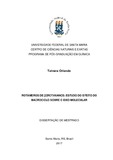| dc.creator | Orlando, Tainára | |
| dc.date.accessioned | 2018-08-07T17:44:44Z | |
| dc.date.available | 2018-08-07T17:44:44Z | |
| dc.date.issued | 2017-07-20 | |
| dc.identifier.uri | http://repositorio.ufsm.br/handle/1/14028 | |
| dc.description.abstract | This work presents the synthesis of three new threads and three new [2]rotaxanes models that have asymmetric stopprs, which allows rotamers to be obtained. The synthesis of the [2]rotaxanes was performed by clipping reaction, where yields were obtained between 22-58%. The rotamers formed were quantified in solution (by 1H NMR spectroscopy) and by theoretical calculations, with the Gibbs free energy was obteined by the optimization of the structures. What can be observed is that the existence of the macrocycle around the thread causes changes in the ratio of rotamers. These changes can be explained by the different intramolecular interactions in the mechanically interlocked molecular. Topological and energetic approach provides information on the contact surface area, interactions energy and paths of interaction intramolecular and intermolecular. Experiments to obtain rotational barrier energy in [2]rotaxanes were carried showing different values for each rotamer of [2]rotaxanes studied. The conformational population and the pirouetting barrier of [2]rotaxanes were correlated with the intramolecular interaction paths, showing that for the [2]rotaxanes synthesized in this work the CH···π type interactions contribute significantly to the estabilization energy and pirouetting barrier. Furthermore, crystallization mechanisms were proposed for the threads and [2]rotaxanes of this work. | eng |
| dc.description.sponsorship | Coordenação de Aperfeiçoamento de Pessoal de Nível Superior - CAPES | por |
| dc.language | por | por |
| dc.publisher | Universidade Federal de Santa Maria | por |
| dc.rights | Attribution-NonCommercial-NoDerivatives 4.0 International | * |
| dc.rights.uri | http://creativecommons.org/licenses/by-nc-nd/4.0/ | * |
| dc.subject | [2]rotaxanos | por |
| dc.subject | Rotâmeros | por |
| dc.subject | População conformacional | por |
| dc.subject | Energia de estabilização | por |
| dc.subject | [2]rotaxanes | eng |
| dc.subject | Rotamers | eng |
| dc.subject | Conformational population | eng |
| dc.subject | Stabilization energy | eng |
| dc.title | Rotâmeros de [2]rotaxanos: estudo do efeito do macrociclo sobre o eixo molecular | por |
| dc.title.alternative | Rotamers of [2]rotaxanes: study of macrocycle effect on the thread | eng |
| dc.type | Dissertação | por |
| dc.description.resumo | Este trabalho apresenta a síntese de três novos eixos moleculares e três novos [2]rotaxanos, os quais possuem grupos volumosos assimétricos, o que permite a obtenção de rotâmeros. A síntese dos [2]rotaxanos foi realizada através da reação de clipping, onde se obteveram rendimentos entre 22-58%. Os rotâmeros formados foram quantificados em solução, através da espectroscopia de RMN de 1H, e por cálculos teóricos, com a obtenção da energia livre de Gibbs pela otimização das estruturas. O que pode ser observado, é que a existência do macrociclo em torno do eixo molecular causa mudanças na proporção dos rotâmeros. Estas mudanças podem ser explicadas pelas diferentes interações intramoleculares existentes na molécula entrelaçada. Estudos topológicos e energéticos forneceram informações sobre a área de contato, energia das interações e caminhos de interação intramoleculares e intermoleculares. Experimentos de obtenção da energia de barreira rotacional nos [2]rotaxanos foram realizados, exibindo valores distintos para cada rotâmero de [2]rotaxanos estudados. Os valores de população conformacional e barreira rotacional dos [2]rotaxanos foram correlacionados com os caminhos de interação intramoleculares, mostrando que, para os [2]rotaxanos sintetizados neste trabalho, as interações do tipo CH···π contribuem significativamente para o aumeto da energia de estabilização e a barreira rotacional. Ainda, mecanismos de cristalização foram propostos para os eixos moleculares e [2]rotaxanos deste trabalho. | por |
| dc.contributor.advisor1 | Hörner, Manfredo | |
| dc.contributor.advisor1Lattes | http://lattes.cnpq.br/8922528250830998 | por |
| dc.contributor.referee1 | Resende, Jarbas Magalhães | |
| dc.contributor.referee1Lattes | http://lattes.cnpq.br/4995867883627482 | por |
| dc.contributor.referee2 | Villetti, Marcos Antonio | |
| dc.contributor.referee2Lattes | http://lattes.cnpq.br/8504489050993642 | por |
| dc.creator.Lattes | http://lattes.cnpq.br/6896595996701518 | por |
| dc.publisher.country | Brasil | por |
| dc.publisher.department | Química | por |
| dc.publisher.initials | UFSM | por |
| dc.publisher.program | Programa de Pós-Graduação em Química | por |
| dc.subject.cnpq | CNPQ::CIENCIAS EXATAS E DA TERRA::QUIMICA | por |
| dc.publisher.unidade | Centro de Ciências Naturais e Exatas | por |



